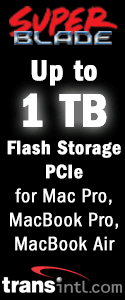Has Bare Feats helped you? How about donating to Bare Feats? |
"BARE facts on Mac speed FEATS" |
||||||||||||||||||||||||||||||||||
"Why isn't Apple supporting SLI mode with adjacent 16 lane PCI Express slots?" For those of you who aren't familiar with the term, "SLI" stands for "Scalable Link Interface" where special edge connectors on the top of PCI Express graphics cards enable you to link adjacent cards using a special jumper, thereby providing scalability and increased performance. "I heard that any PCI Express graphics card will work in the new G5 Power Mac -- not just those sold by Apple. Is this true?" The reason Apple shifted to PCI Express is simple: bandwidth. The 16 lane PCI Express slot has a concurrent bandwidth of 4GB/s each direction (compared to 2.1GB/s for 8X AGP). The 8 lane clocks 2GB/s per direction. The 4 lane is rated at 1GB/s. The fastest previous PCI-X slot (133) ran at 1GB/s. Most high end Windows PCs I've tested recently come with both PCI Express slots and PCI-X slots. That's probably because they know pro users often have an investment in "legacy" cards. I think Apple should have configured the new G5 with dual PCI-X 133 slots and dual 16 lane PCI Express slots with SLI support. Apple's actually offers a solution for those with a large investment in PCI-X cards. They suggest that they buy April's G5/2.7GHz Power Mac. which they are either still building or still have piled up in the warehouse. Apple has a special page telling about it. For more technical information on PCI Express, visit the Special Interest Group site. "Where's the performance graphs?" 1. Dual-Core G5/2.0GHz Power Mac vs Single-Core Dual G5/2.0 Power Mac 2. Quad-Core G5/2.5GHz Power Mac vs Single-Core Dual G5/2.5 Power Mac WHERE TO ORDER YOUR DUAL-CORE G5 POWER MAC When ordering products from Apple Store USA, please click THIS TEXT LINK or any Apple display ad as your "portal" to the online store. In so doing, you help to support Bare Feats. Other World Computing has very good prices for both 2GB and 4GB PC2-4200 non-ECC memory kits for the Dual-Core and Quad-Core G5 Power Mac. The 2GB (1GB x2) kit is $175. The 4GB (2G x 2) kit is $530. Both kits are in stock. Some of you have asked about ECC memory. ECC memory can handle one bit errors without crashing the app or system. But with multiple bit errors and "kaboom" -- no matter what kind of memory you have. It isn't slower than non-ECC memory -- nor is it faster. If you want to go with ECC for your Quad or Dual-Core, OWC has the 2GB ECC kits for $340 and the 4GB ECC kits for $675. Some of you have asked which "older" G5 Power Mac models are most desirable. I recommend getting a model with 8 memory slots, 100/133MHz PCI-X slots, and 600W Power Supply. The table below gives the model number, etc., of these most desirable older G5s.
PCI EXPRESS HOST ADAPTERS
Has Bare Feats helped you? How about helping Bare Feats?
|







